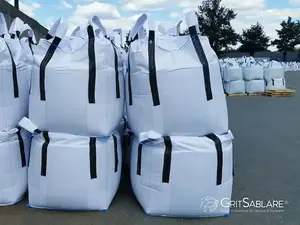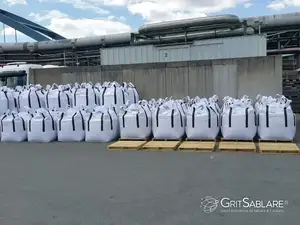
We offer complete authorized environmental services for the collection and recovery of used blasting material purchased from us.
Angular Shape

Blasting Materials distributed by GritSablare are characterized by outstanding quality. This quality is reflected in an above-average service life, a very high productivity and value retention.
Copper Slag
- No. 1 Blasting Material in Europe, made in the EU, multifaceted particles, vitreous amorphous slag, 7.5 Mohs Hardness. Increased efficiency, up to 30% higher than any other similar agent for outdoor blasting, on almost any type of surface, indoor and outdoor.
- Toxicological Certificate, < 0,1% Free Silica. On demand, we provide Toxicological Certificate that certifies the content of toxic, carcinogenic and free silica elements. In accordance with EU Regulation REACH, CLP Regulation EC/1272/200 and the Dangerous Substances Directive 67/548/ EEC, the product is classified as not-dangerous.
- Uses: Blasting Agent • Concrete filler • Anti-slip screed • Road surface dressing • Building material • Mortar • Colorant.
- The material is washed several times during the manufacturing process, therefore is a low dusting material.
ISO Certified 11127
Certificate
Material in EU
- Reusable Material, up to 3 operating cycles depending on application, for the following types:
#1 [0,5 – 2,5 mm] and #2 [0.5 – 1.4 mm]
- #1 [0,5 – 2,5 mm]
- #2 [0.5 – 1.4 mm]
- #3 [0,2 – 2,0 mm]
- #4 [0,2 – 1,4 mm]
- #5 [0,2 – 1,0 mm]
- Big Bags of 1.8 Tonnes
[Types #1, #2, #3 si #4] - Bags of 30 Kg
[Type #5]
- The material must be stored in a dry place.
We offer comprehensive blasting waste recovery services for neutralization. For further details, please contact us.
Copper Slag Description

(Prem & Verna, 2018)
- Copper slag is a byproduct obtained during smelting and refining of copper ore rich in sulphides and oxides of iron and copper, in the course of removing iron as iron silicate. During the smelting process at 1250°C, copper liquid settles down due to higher density while copper slag remain on the surface in the segregated state. The copper slag is then collected and cooled with jets of pressurised water. The associated thermal shock creates a unique, glassy amorphous granulate. During the manufacture of the abrasive no crushing or grinding procedures are included. Therefore, the single abrasive particle is not broken up and retains its extreme hardness and tenacity which is the case for all particle sizes. Further, to obtain maximum blasting operating results, the particles are washed multiple times and carefully screened on different grain sizes.
- Due to its special features, copper slag is recognized for increased blasting efficiency and reaches a maximum potential in cleaning surfaces and material savings.
- Cleaning Efficiency. Particle density and velocity are the two major contributors in determining the efficiency of an abrasive material. The angularity of the GritSablare grains allows the material to gain greater energy from the nozzle, resulting in extremely high velocity, whilst the particles’ high specific density delivers optimum cleaning power to the surface. Consequently, GritSablare provides powerful fast cleaning and an optimum prepared surface for any coating system.
- Lower Consumption. In addition to its cleaning efficiency, the consumption of an abrasive also depends on its ability to remove the old coating whilst at the same time producing a satisfactory surface profile. The best surfaces are created by abrasives with a mixture of particle sizes. With GritSablare, particle size distribution is optimised to ensure the best performance which means a notably lower consumption. Particle size distribution is controlled at the production facility with rigid adherence to specified grain sizes.
High quality Copper slag
Blasting Waste Recovery
Our company is concerned to minimize the impact of its activities on the environment by offering blasting materials and equipment that are friendly to the environment and nature.
In addition, we offer Copper Slag waste recovery service for neutralization, by complying to the provisions and guidance norms regarding the recovery and reuse of the blasting materials in an ecological manner.
FREE
Service
We offer FREE waste recovery service for the copper slag provided by our company. *
* The offer does not include freight charges and handling costs.
We provide transportation and handling services at the most competitive prices for recovering copper slag waste.
For more information, contact us!
Copper Slag Types
Rough Particles [#1 and #2]
Medium Particles [#3]
Fine Particles [#4 and #5]
Physical and Chemical Properties
| Physical Properties | |
|---|---|
| Chemical Family: | Copper slag |
| Commercial names: | Copper Slag, Iron Silicate Abrasives, Iron Silicate Grit |
| Shape: | Multifaceted particles, vitreous amorphous slag |
| Physical state: | Solid particles |
| Appearance: | Glassy black |
| Odour: | None |
| Hardness: | 7.5 Mohs Scale |
| Specific density: | (approx.) 3,7 kg/dm3 |
| Conductivity: | < 20 mS/m |
| Water-soluble chlorides: | < 0,0025% (m/m) |
| Chemical composition | |
|---|---|
| SiO2: | 33 - 38% (Free Silica < 0,1%) |
| FeO: | 51 - 58% |
| Al2O3: | 4 - 8% |
| CaO: | 2 - 10% |
| K2O: | 0 - 2% |
| MgO: | 1 - 3% |
| S: | 0,6 - 1,3% |
| Other: | traces |
ISO Standard 11127 Certified
ISO 11127 Certified – Preparation of steel substrates before application of paints and related products - Test methods for non-metallic blast-cleaning abrasives.
Certificate
On demand, we provide Toxicological Certificate that certifies the content of toxic, carcinogenic and free silicate elements. In accordance with EU Regulation REACH, CLP Regulation EC/1272/200 and the Dangerous Substances Directive 67/548/ EEC, the product is classified as not-dangerous.
Copper Slag Applications






- Granular replacement for different mixtures;
- Colorant additive;
- Anti-slippery material;
- Underground Mine Backfilling.
User Safety Copper Slag
The substance is not classified as hazardous under the CLP Regulation (1272/2008/EC), is not persistent bio-accumulative and toxic (PBT) or very persistent and very bio-accumulative (vPvB) as defined in Annex XIII of the REACH Regulation, and is not included in the ECHA candidate list of substances of very high concern.
Exposure controls: Risk management measures aimed at the protection of human health are to be considered in cases of inhalation of powder or dusts during use. Process enclosures, local exhaust ventilation or other engineering controls should be employed to keep worker exposure to airborne contaminants below any recommended or statutory limits.
Personal protective equipment: Wear suitable protective clothing.
Hand protection: Wear suitable gloves. Where necessary, gauntlets should be worn to protect against abrasive ricochet.
Respiratory protection: Use properly fitted respiratory protection, complying with an approved standard, appropriate for the known or anticipated exposure levels and the hazards of the product. Blasters should wear an air-fed blasting helmet complying with approved standards, to afford the correct level of respiratory and eye/face protection.
Eye/face protection: Safety eyewear complying with an approved standard should be used when a risk assessment indicates this is necessary to avoid exposure to dusts. If operating conditions cause high dust concentrations wear dust goggles.
Hygiene measures: Handle in accordance with good industrial hygiene and safety practices. Wash hands, forearms and face thoroughly before eating or smoking and at the end of the working period. Routinely wash work clothing and protective equipment to remove contaminants.
Environmental exposure controls: Emissions from ventilation or work process equipment should be checked to ensure they comply with the requirements of the environmental protection legislation.
Testimonials
A beautiful collaboration, quality, promptitude and honesty carried us on a beautiful road...
Răzvan Harabagiu, Shareholder | Executive Manager, Alpaccess, Romania
A trustworthy brand, a professional team, a flawless service! We are happy to have them as our supplier for blasting agents and equipment.
Iulian Duna, Project Manager, Industrial Cruman, Ploiești - Romania
GritSablare, a reliable and fast partner, always involved to learn and find solutions that fits customers' needs.
Daniel Morari, COSMA Glass - water jet cutting
GritSablare, the largest blasting warehouse we are aware of... a flexible payment schedule for blasting equipment, moreover, a very good choice!
Ionel Zelca, Owner, Industrial Painting SRL - blasting and electrostatic painting




We provide first-class quality products, build long term relationships and develop strong connections with our clients








